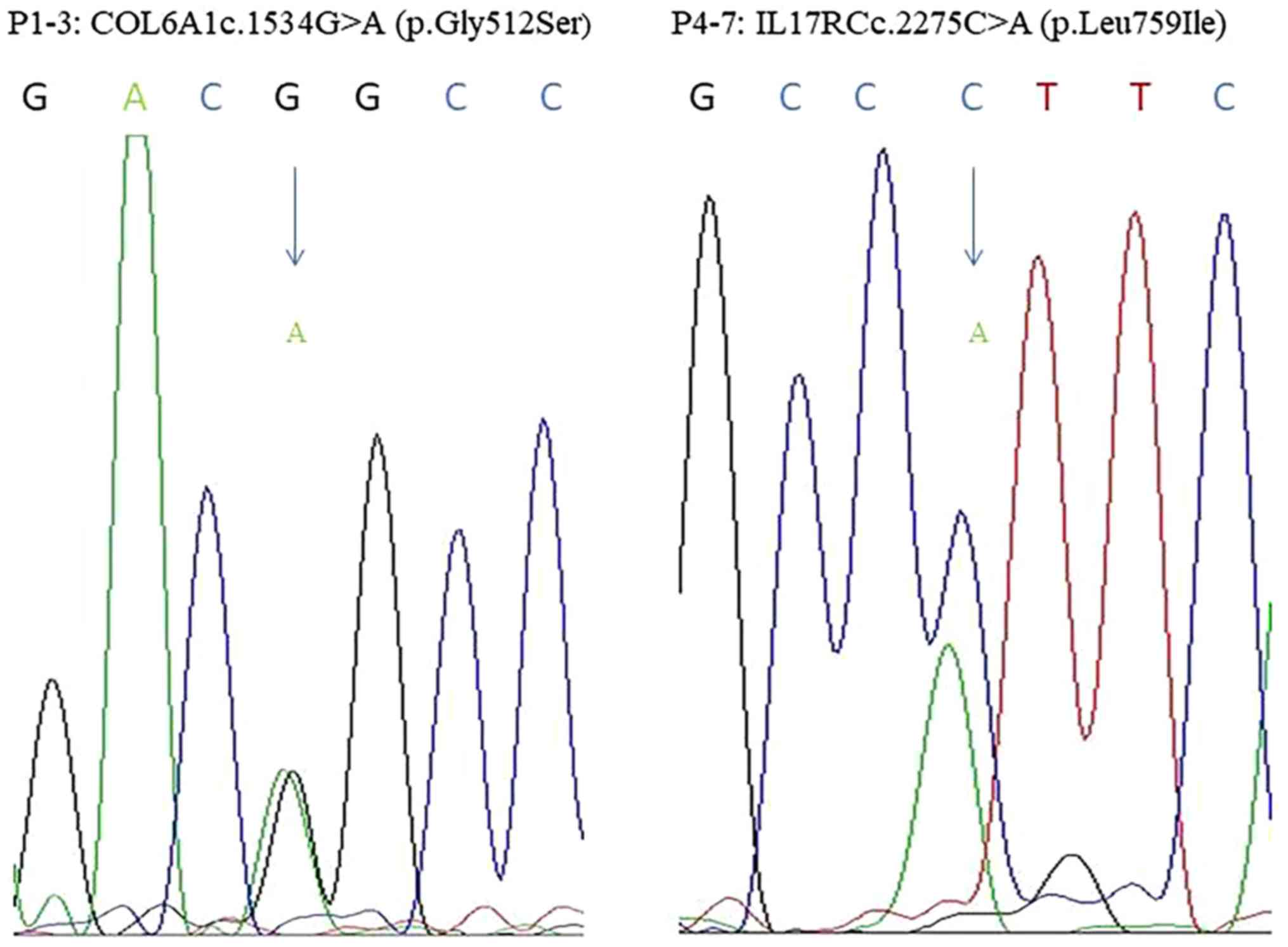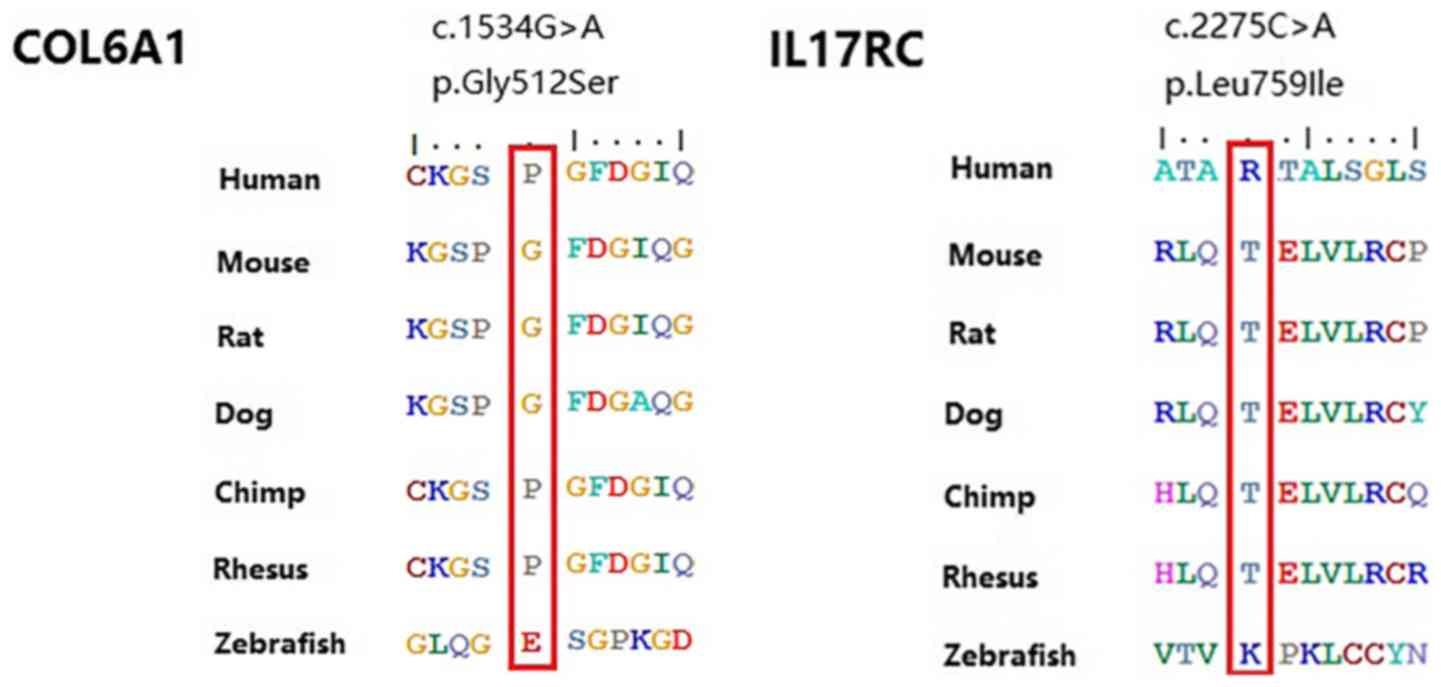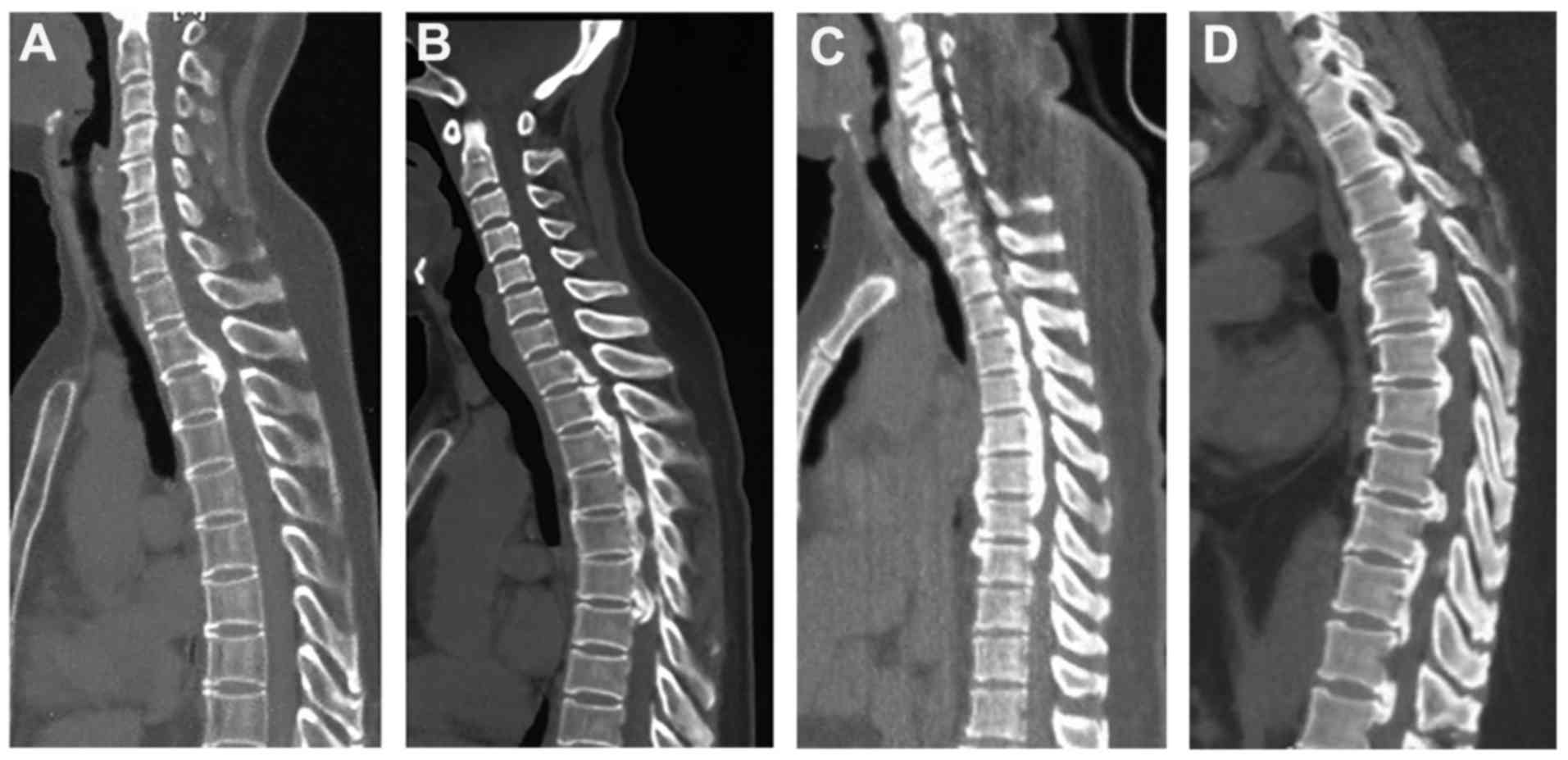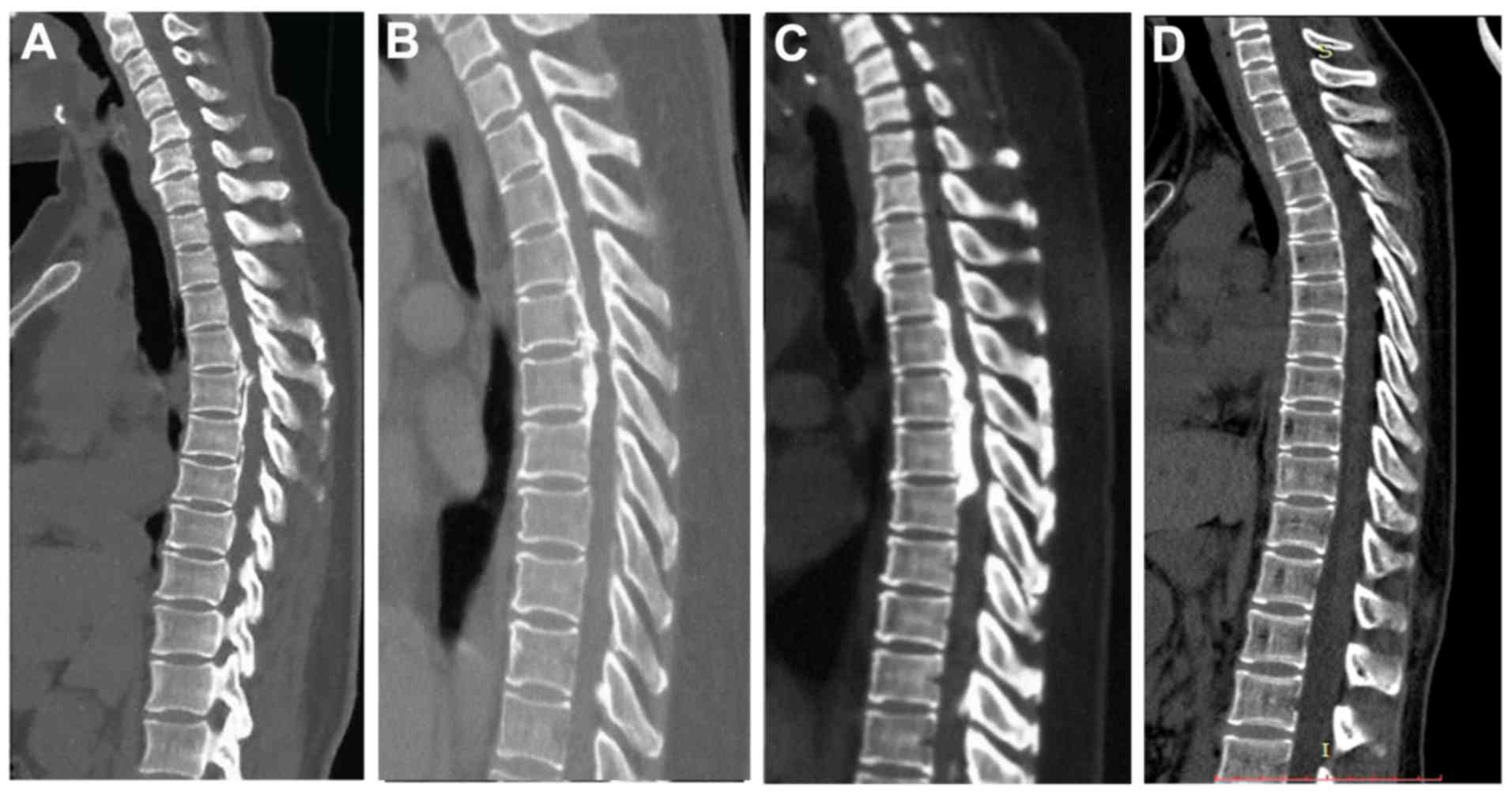|
1
|
Kim KH, Kuh SU, Park JY, Lee SJ, Park HS,
Chin DK, Kim KS and Cho YE: Association between BMP-2 and COL6A1
gene polymorphisms with susceptibility to ossification of the
posterior longitudinal ligament of the cervical spine in Korean
patients and family members. Genet Mol Res. 13:2240–2247. 2014.
View Article : Google Scholar : PubMed/NCBI
|
|
2
|
Nagashima C: Cervical myelopathy due to
ossification of the posterior longitudinal ligament. J Neurosurg.
37:653–660. 1972. View Article : Google Scholar : PubMed/NCBI
|
|
3
|
Yonemori K, Imamura T, Ishidou Y, Okano T,
Matsunaga S, Yoshida H, Kato M, Sampath TK, Miyazono K, ten Dijke P
and Sakou T: Bone morphogenetic protein receptors and activin
receptors are highly expressed in ossified ligament tissues of
patients with ossification of the posterior longitudinal ligament.
Am J Pathol. 150:1335–1347. 1997.PubMed/NCBI
|
|
4
|
Ikegawa S: Genetics of ossification of the
posterior longitudinal ligament of the spine: A mini review. J Bone
Meta. 21:127–132. 2014. View Article : Google Scholar
|
|
5
|
Tsuji T, Chiba K, Hosogane N, Fujita N,
Hikata T, Iwanami A, Watanabe K, Ishii K, Toyama Y, Nakamura M and
Matsumoto M: Epidemiological survey of ossification of the
posterior longitudinal ligament by using clinical investigation
registration forms. J Orthop Sci. 21:291–294. 2016. View Article : Google Scholar : PubMed/NCBI
|
|
6
|
Fujimori T, Watabe T, Iwamoto Y, Hamada S,
Iwasaki M and Oda T: Prevalence, concomitance and distribution of
ossification of the spinal ligaments: Results of Whole Spine CT
Scans in 1500 Japanese Patients. Spine (Phila Pa 1976).
41:1668–1676. 2016. View Article : Google Scholar : PubMed/NCBI
|
|
7
|
Chen X, Guo J, Cai T, Zhang F, Pan S,
Zhang L, Wang S, Zhou F, Diao Y, Zhao Y, et al: Targeted
next-generation sequencing reveals multiple deleterious variants in
OPLL-associated genes. Sci Rep. 6:269622016. View Article : Google Scholar : PubMed/NCBI
|
|
8
|
Kong Q, Ma X, Li F, Guo Z, Qi Q, Li W,
Yuan H, Wang Z and Chen Z: COL6A1 polymorphisms associated with
ossification of the ligamentum flavum and ossification of the
posterior longitudinal ligament. Spine (Phila Pa 1976).
32:2834–2838. 2007. View Article : Google Scholar : PubMed/NCBI
|
|
9
|
Tanaka T, Ikari K, Furushima K, Okada A,
Tanaka H, Furukawa K, Yoshida K, Ikeda T, Ikegawa S, Hunt SC, et
al: Genomewide linkage and linkage disequilibrium analyses identify
COL6A1, on chromosome 21, as the locus for ossification of the
posterior longitudinal ligament of the spine. Am J Hum Genet.
73:812–822. 2003. View
Article : Google Scholar : PubMed/NCBI
|
|
10
|
Koga H, Sakou T, Taketomi E, Hayashi K,
Numasawa T, Harata S, Yone K, Matsunaga S, Otterud B, Inoue I and
Leppert M: Genetic mapping of ossification of the posterior
longitudinal ligament of the spine. Am J Hum Genet. 62:1460–1467.
1998. View
Article : Google Scholar : PubMed/NCBI
|
|
11
|
Wang H, Liu D, Yang Z, Tian B, Li J, Meng
X, Wang Z, Yang H and Lin X: Association of bone morphogenetic
protein-2 gene polymorphisms with susceptibility to ossification of
the posterior longitudinal ligament of the spine and its severity
in Chinese patients. Eur Spine J. 17:956–964. 2008. View Article : Google Scholar : PubMed/NCBI
|
|
12
|
Kamiya M, Harada A, Mizuno M, Iwata H and
Yamada Y: Association between a polymorphism of the transforming
growth factor-beta1 gene and genetic susceptibility to ossification
of the posterior longitudinal ligament in Japanese patients. Spine
(Phila Pa 1976). 26:1264–1267. 2001. View Article : Google Scholar : PubMed/NCBI
|
|
13
|
Ogata N, Koshizuka Y, Miura T, Iwasaki M,
Hosoi T, Shiraki M, Seichi A, Nakamura K and Kawaguchi H:
Association of bone metabolism regulatory factor gene polymorphisms
with susceptibility to ossification of the posterior longitudinal
ligament of the spine and its severity. Spine (Phila Pa 1976).
27:1765–1771. 2002. View Article : Google Scholar : PubMed/NCBI
|
|
14
|
Kim DH, Jeong YS, Chon J, Yoo SD, Kim HS,
Kang SW, Chung JH, Kim KT and Yun DH: Association between
interleukin 15 receptor, alpha (IL15RA) polymorphism and Korean
patients with ossification of the posterior longitudinal ligament.
Cytokine. 55:343–346. 2011. View Article : Google Scholar : PubMed/NCBI
|
|
15
|
Guo Q, Lv SZ, Wu SW, Tian X and Li ZY:
Association between single nucleotide polymorphism of IL15RA gene
with susceptibility to ossification of the posterior longitudinal
ligament of the spine. J Orthop Surg Res. 9:1032014. View Article : Google Scholar : PubMed/NCBI
|
|
16
|
Liu Y, Zhao Y, Chen Y, Shi G and Yuan W:
RUNX2 polymorphisms associated with OPLL and OLF in the Han
population. Clin Orthop Relat Res. 468:3333–3341. 2010. View Article : Google Scholar : PubMed/NCBI
|
|
17
|
Tsuyama N: Ossification of the posterior
longitudinal ligament of the spine. Clin Orthop Relat Res. 1–84.
1984.
|
|
18
|
Li H and Durbin R: Fast and accurate
long-read alignment with Burrows-Wheeler transform. Bioinformatics.
26:589–595. 2010. View Article : Google Scholar : PubMed/NCBI
|
|
19
|
Li H and Durbin R: Fast and accurate short
read alignment with Burrows-Wheeler transform. Bioinformatics.
25:1754–1760. 2009. View Article : Google Scholar : PubMed/NCBI
|
|
20
|
McKenna A, Hanna M, Banks E, Sivachenko A,
Cibulskis K, Kernytsky A, Garimella K, Altshuler D, Gabriel S, Daly
M and DePristo MA: The genome analysis toolkit: A MapReduce
framework for analyzing next-generation DNA sequencing data. Genome
Res. 20:1297–1303. 2010. View Article : Google Scholar : PubMed/NCBI
|
|
21
|
DePristo MA, Banks E, Poplin R, Garimella
KV, Maguire JR, Hartl C, Philippakis AA, del Angel G, Rivas MA,
Hanna M, et al: A framework for variation discovery and genotyping
using next-generation DNA sequencing data. Nat Genet. 43:491–498.
2011. View
Article : Google Scholar : PubMed/NCBI
|
|
22
|
Sim NL, Kumar P, Hu J, Henikoff S,
Schneider G and Ng PC: SIFT web server: Predicting effects of amino
acid substitutions on proteins. Nucleic Acids Res. 40:W452–W457.
2012. View Article : Google Scholar : PubMed/NCBI
|
|
23
|
Adzhubei IA, Schmidt S, Peshkin L,
Ramensky VE, Gerasimova A, Bork P, Kondrashov AS and Sunyaev SR: A
method and server for predicting damaging missense mutations. Nat
Methods. 7:248–249. 2010. View Article : Google Scholar : PubMed/NCBI
|
|
24
|
Schwarz JM, Cooper DN, Schuelke M and
Seelow D: MutationTaster2: Mutation prediction for the
deep-sequencing age. Nat Methods. 11:361–362. 2014. View Article : Google Scholar : PubMed/NCBI
|
|
25
|
Davydov EV, Goode DL, Sirota M, Cooper GM,
Sidow A and Batzoglou S: Identifying a high fraction of the human
genome to be under selective constraint using GERP++. PLoS Comput
Biol. 6:e10010252010. View Article : Google Scholar : PubMed/NCBI
|
|
26
|
Wiberg C, Klatt AR, Wagener R, Paulsson M,
Bateman JF, Heinegård D and Mörgelin M: Complexes of matrilin-1 and
biglycan or decorin connect collagen VI microfibrils to both
collagen II and aggrecan. J Biol Chem. 278:37698–37704. 2003.
View Article : Google Scholar : PubMed/NCBI
|
|
27
|
Tsukahara S, Miyazawa N, Akagawa H,
Forejtova S, Pavelka K, Tanaka T, Toh S, Tajima A, Akiyama I and
Inoue I: COL6A1, the candidate gene for ossification of the
posterior longitudinal ligament, is associated with diffuse
idiopathic skeletal hyperostosis in Japanese. Spine (Phila Pa
1976). 30:2321–2324. 2005. View Article : Google Scholar : PubMed/NCBI
|
|
28
|
Ho AW and Gaffen SL: IL-17RC: A partner in
IL-17 signaling and beyond. Semin Immunopathol. 32:33–42. 2010.
View Article : Google Scholar : PubMed/NCBI
|
|
29
|
Huang H, Kim HJ, Chang EJ, Lee ZH, Hwang
SJ, Kim HM, Lee Y and Kim HH: IL-17 stimulates the proliferation
and differentiation of human mesenchymal stem cells: Implications
for bone remodeling. Cell Death Differ. 16:1332–1343. 2009.
View Article : Google Scholar : PubMed/NCBI
|
|
30
|
Mohammad KS, Chen CG, Balooch G, Stebbins
E, McKenna CR, Davis H, Niewolna M, Peng XH, Nguyen DH,
Ionova-Martin SS, et al: Pharmacologic inhibition of the TGF-beta
type I receptor kinase has anabolic and anti-catabolic effects on
bone. PLoS One. 4:e52752009. View Article : Google Scholar : PubMed/NCBI
|
|
31
|
Mukherjee S, Schaller MA, Neupane R,
Kunkel SL and Lukacs NW: Regulation of T cell activation by Notch
ligand, DLL4, promotes IL-17 production and Rorc activation. J
Immunol. 182:7381–7388. 2009. View Article : Google Scholar : PubMed/NCBI
|
|
32
|
Niu CC, Lin SS, Yuan LJ, Chen LH, Yang CY,
Chung AN, Lu ML, Tsai TT, Lai PL and Chen WJ: Correlation of blood
bone turnover biomarkers and Wnt signaling antagonists with AS,
DISH, OPLL, and OYL. BMC Musculoskelet Disord. 18:612017.
View Article : Google Scholar : PubMed/NCBI
|
|
33
|
Ikegawa S: Genomic study of ossification
of the posterior longitudinal ligament of the spine. Proc Jpn Acad
Ser B Phys Biol Sci. 90:pp. 405–412. 2014; View Article : Google Scholar : PubMed/NCBI
|
|
34
|
Nakajima M, Takahashi A, Tsuji T, Karasugi
T, Baba H, Uchida K, Kawabata S, Okawa A, Shindo S, Takeuchi K, et
al: A genome-wide association study identifies susceptibility loci
for ossification of the posterior longitudinal ligament of the
spine. Nat Genet. 46:1012–1016. 2014. View
Article : Google Scholar : PubMed/NCBI
|
|
35
|
Ohtsuka K, Terayama K, Yanagihara M, Wada
K, Kasuga K, Machida T and Matsushima S: A radiological population
study on the ossification of the posterior longitudinal ligament in
the spine. Arch Orthop Trauma Surg. 106:89–93. 1987. View Article : Google Scholar : PubMed/NCBI
|













